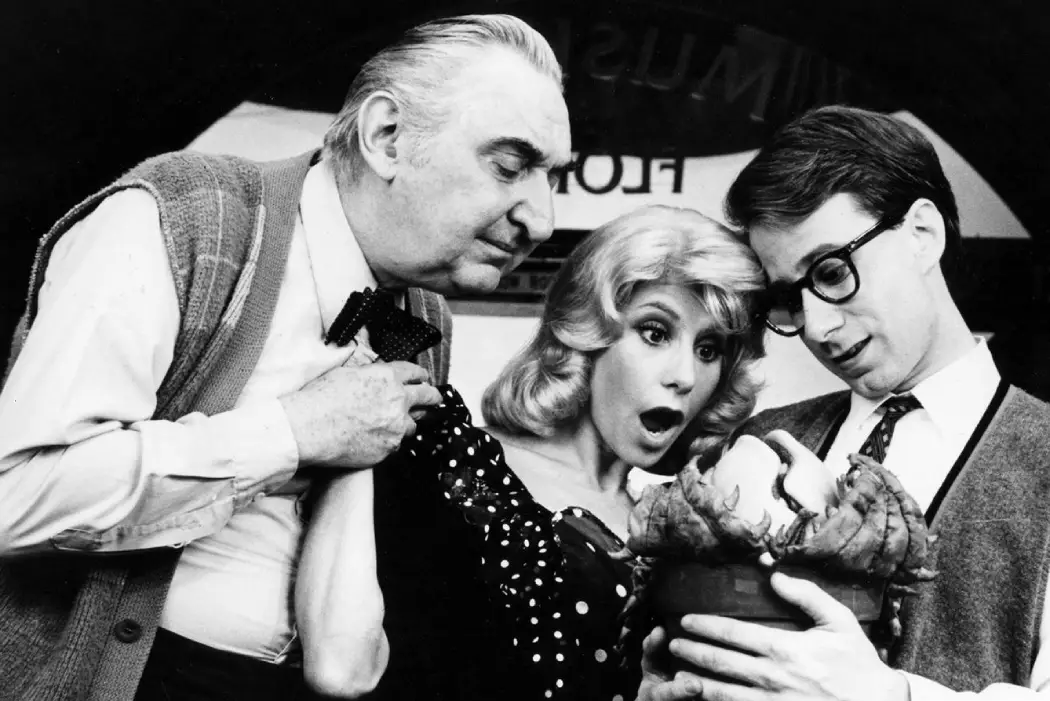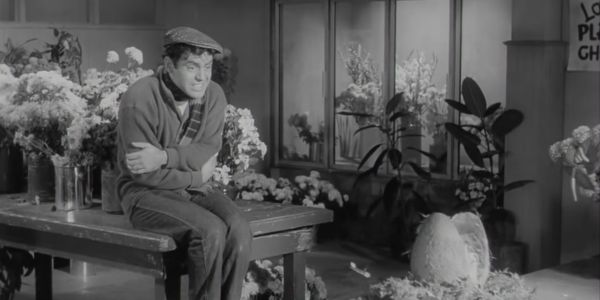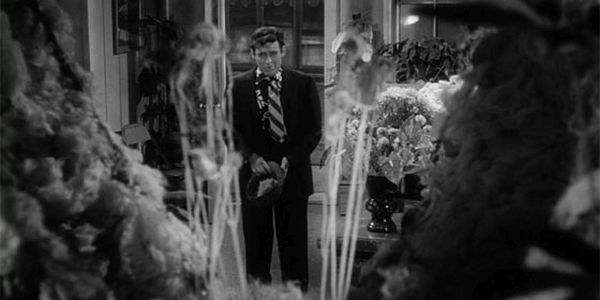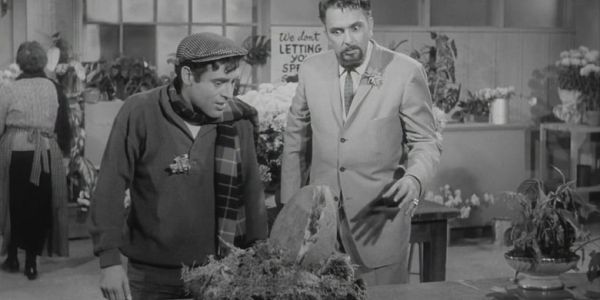LITTLE SHOP OF HORRORS At 60: Social Change and White Male Anxiety

Danny Anderson teaches English at Mount Aloysius College in PA.…
As we await another musical adaptation of Little Shop of Horrors, it’s worth looking back to Roger Corman’s campy 1960 original film. Before inspiring all of the catchy musical numbers, Corman’s film remains an absurd, slapstick comedy with a sharp mix of stark depression.
Mainly remembered for inspiring a massively successful musical and a memorable early performance by a delightfully bizarre Jack Nicholson, the film deserves a second look on its 60th anniversary. For one thing, it serves as a prime example of Corman’s masterful low-budget production method; this is another tightly efficient film that adds up to much more than the sum of its parts.
But in addition to its technical skill, when considering when this film was made, right at the division between two epochs in American history, the blissful 50s, and the tumultuous 60s, one is struck by how insightful it was about its time and place. One is also struck by the film’s bitter lament over the diminishing power of the white male in American life.
Its main character, meek Seymour, is caught between multiple paralyzing pressures that reveal the film’s underlying rage at social upheaval. His aging mother still controls his life, his perspective mate is out of his social league, his boss constantly holds the threat of dismissal over his head, and these factors all lead to his terrifying commitment to a carnivorous plant, which ultimately demands his soul and body.

I’d like to argue that Little Shop of Horrors weaves at least sources of patriarchal anxiety into its horror: fear of an ethnic other, an increasingly empowered feminism, and frustration with capitalism’s effects on masculinity.
The Plot
Corman’s silly little tale follows meek and clumsy Seymour (Jonathan Haze) who works on Skid Row in Mushnick’s flower shop with the sweet and attractive Audrey (Jackie Joseph). Under pressure from Mushnick (Mel Welles, whose over-the-top stereotypical Jewish shop owner is hilarious if more than a little uncomfortable now) Seymour creates a new breed of Venus Flytrap to serve as a showcase for Mushnick’s struggling business. The plant, named Audrey Jr. by Seymour, turns out to be a big hit, but unfortunately feeds on human flesh and blood, forcing Seymour into some rather ghoulish nighttime activities.
White Male Anxiety
On every level, the film is a drive-in quickie. The humor is low brow and the horror lurid. These are not bad things, mind you. The movie remains shockingly entertaining sixty years later. But low brow art shares something in common with its high brow cousin: both serve to offer an offensive critique of the vast, oblivious middlebrow, which wants its art mainly to serve as something unchallenging to consume. Little Shop of Horrors can be offensive at times in its casual joke-making about ethnicity and gender, but it is also surprisingly subversive and helps mark a stark division between the pleasant idealism of Eisenhower’s Fifties and the tumultuous Sixties.
Seymour’s plight can be seen as an exploration of white male anxiety in a period of massive social changes. His anxiety takes three forms: racial, gender-based, and economic.
Race and Ethnicity
The diminishing power of whiteness informs much of the film’s nightmarish landscape.
Mushnick, whose Jewishness is outrageously stereotyped in the film, exercises almost complete control over Seymour. The film begins with him firing our protagonist for various forms of incompetence but giving him a chance to earn his position back if he can deliver his miracle plant. At all times, his greed and power help keep Seymour dangling on a string like a puppet. The shop owner’s portrayal is uncomfortably consistent with the anti-Semitic depictions of Jewish business owners of much far-right and fascist conspiratorial propaganda.
Jack Nicholson’s memorable comic turn in the film is also burdened with the anxiety of white men in 1960. His character, the masochistic patron of Skid Row’s famously sadistic dentist, is a madman. His perverse pleasure at the experience of pain is no doubt hilarious, but it leaves no question about the state of his mind. The character’s name, Wilbur Force, is another hammy joke in a film laden with them, but when one considers the reference this joke makes, the film’s general racial anxiety comes even further into focus.

William Wilberforce is the name of the British statesman who embodies the movement to abolish the slave trade. By using this particular name for one of its puns, the film, inadvertently or not, makes a rather ugly claim about the rising tide of equality for people of color, right in the middle of the American Civil Rights Movement. Applying Wilberforce’s name to a masochistic maniac, the film makes a shocking statement about white anxiety.
Monstrous Femininity
The patriarchal nature of Seymour’s anxiety utterly permeates the film as well.
Part of the reason Seymour is such a schmuck is his subservience to his hypochondriac, drunken mother. Her utter control over his life manifests most clearly in his failure to go away with Audrey, but the film leaves little doubt about tracing his generally meek personality to her overbearing influence.
Beyond these obvious Freudian themes, however, Little Shop’s very genetic core is derived from a fear of the feminine.
The use of the Venus flytrap has a long history in horror. Scholars like Barbara Creed (in her great book The Monstrous-Feminine) have long established that horror often encodes its monsters as intrinsically feminine. The flytrap is one such symbol. As far back as 1922’s Nosferatu, the plant was associated with film monsters as a way to code them as feminine. The explicit reference to the vagina makes the Venus flytrap an obvious symbol to employ when expressing a horrific attitude toward femininity. (This metaphor is made literal in the underrated 2007 film Teeth).
Audrey Jr., though voiced by a male actor, is a feminine horror and represents another aspect of the cultural anxiety of white men at the cusp on the Sixties. If there were any doubt about how Seymour has internalized the patriarchal attitudes of his time, one has only to consider his final sacrifice to Audrey Jr. (before he willingly enters the plant himself in the end, that is). Under the plant’s hypnotic spell, Seymour goes out into the night to find yet another victim and passes countless men in the street before coming across a sex worker whom he deems a good sacrifice (if a bit thin for the plant’s taste). He convinces himself that she has volunteered for the sacrifice, which eases his conscience enough to go through with the act. This is an act of pure misogyny and it underscores the film’s attitude toward gender equality at the dawn of the new decade.

Conclusion
The monstrous plant, in addition to representing threatening femininity, also serves as a metaphor for the grueling demands of capitalism. The plant begins as a product of his labor but he soon becomes beholden to its demands and it quickly takes over his very being.
At the beginning, the small plant is satisfied with a few drops of Seymour’s blood, but soon he must deliver the bodies of society’s marginalized for its never-ending consumption. What began as his labor of love, becomes simply labor as the demands of making a livelihood work to destroy Seymour’s humanity.
Little Shop of Horrors is a still fun, but undeniably brutish film. Its crude humor and violence manage to entertain, but underneath its seemingly unambitious low brow aesthetic lies a very angry film. At first glance, it’s easy to feel sorry for Seymour, but we should also consider that his anxiety grows, like Audrey Jr. itself, from a bitter seed.
What other films reflect the anxieties of their times?
Watch Little Shop of Horrors
Does content like this matter to you?
Become a Member and support film journalism. Unlock access to all of Film Inquiry`s great articles. Join a community of like-minded readers who are passionate about cinema - get access to our private members Network, give back to independent filmmakers, and more.
Danny Anderson teaches English at Mount Aloysius College in PA. He tries to help his students experience the world through art. In his own attempts to do this, he likes to write about movies and culture, and he produces and hosts the Sectarian Review Podcast so he can talk to more folks about such things. You can find him on Twitter at. @DannyPAnderson.













